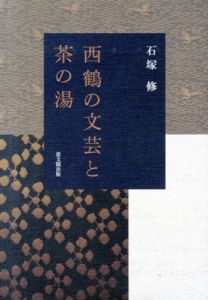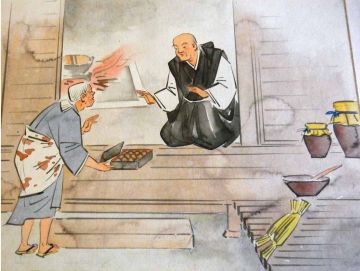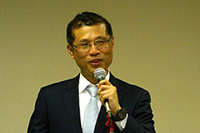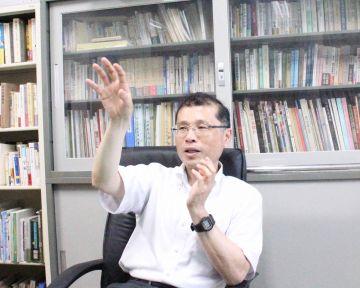TSUKUBA FUTURE
#026 Using Classical Literature to Shed Light on Japanese Food Culture
Professor ISHIZUKA Osamu, Faculty of Humanities and Social Sciences

The enjoyment of foods with slimy, gooey texture such as natto (fermented soybeans), tororo (grated Japanese mountain yam), and eel is one of the features of Japanese food culture. Prior to the scientific substantiation of the chemical components of these foods, it was empirically known that they are foods that provide stamina, a perception that took hold after being passed down through the ages. Prof. Ishizuka specializes in the research of early modern literature such as the works of Ihara Saikaku and the culture of the tea ceremony. His work developed from there and, in addition to pure literary pursuit, he is now engaged in research into how natto spread across Japan and has been eaten, as based on descriptions found in classical literature.
Natto is fermented soybeans. Similar to many other fermented foods, it is speculated that natto was originally the product of a coincidence. While there are several theories about the origin, Prof. Ishizuka believes that a failed attempt at making miso (fermented soybean paste) was where natto began. Miso, which has a longer history than natto, is also a fermented soybean product. According to the theory, there were temperature control problems during the manufacture of miso, and the conditions ended up being more favorable to the fermentation of natto fungus rather than the intended rice malt fungus, thus leading to the creation of natto. This must have come as quite a surprise at first, but somebody did opt to eat it rather than dispose of it. It was most likely a matter of that person not wanting to see it go to waste. Thanks to this person, we who live in the modern day are also able to savor the taste of natto.

In Feb. 2014, Prof. Ishizuka published his research results that verify how profound an impact tea ceremony culture had on the works of Saikaku.

The origins of natto according to the legend of Joshokoji Temple in Kyoto. Part of a scroll painting depicting the life of Emperor Kogon, who became a monk here after falling from power during the historical upheavals caused by the great disturbances between the Southern and Northern Dynasties. (photo courtesy of Prof. Ishizuka)
A villager presents straw-wrapped miso beans that are said to have fermented into natto.
Natto was apparently first eaten in agricultural villages of the mountainous regions of Japan. Though it is now available year round, natto had been a food made in the winter only?between autumn and early spring?after soybeans are harvested and the climate is favorable to fermentation. This is why natto was a word used to indicate the winter in haiku verse. Due to temperature control and other labor-intensive requirements of natto making, it seems to have been eaten only during special occasions such as New Year's and festivals. Furthermore, this was not the usual combination of natto and rice but rather natto soup: that is, miso soup with natto as an added ingredient. This was a smart way of both keeping the body warm and ingesting beneficial protein during cold periods. Even now people use green onions and mustard to flavor their natto, and, according to Prof. Ishizuka, this is a legacy of how natto soup was flavored. Natto soup had even become used as a dish in the tea ceremony banquets of Sen no Rikyu. Natto found a place in the food culture of the common folk of Edo (present-day Tokyo). During the Edo Period, the general practice was to cook rice in the morning, and because people liked their natto with freshly steamed rice, natto soup and rice became a popular breakfast combination. In the later part of the Edo era, summertime natto production was started as well, and apparently pounded natto was combined with tofu and green onion into a purchasable "natto soup set" that made natto soup easy to make. Those who did not want to go to the trouble of making soup simply started to eat their natto by putting it on top of their rice. So it was that natto became a staple of the standard breakfast menu.

Prof. Ishizuka plies his considerable oratorical skills to enrapture an audience as he gives a talk on the culture of natto.At the "10th Natto Health Science Seminar" in May 2014
(photo courtesy of the website of the Japan Natto Cooperative Society Federation)
The University of Tsukuba library has an extensive collection of classical books and historical materials. At present the archived materials of diverse institutions are available by database and relatively easy to search by keyword. However, the important work is what takes place next: that is, retrieving the right information from massive archives and then classifying and analyzing. Picking apart the historical and cultural contexts that provide the background of the materials and then verifying the written content is the very essence of research. This means going beyond the walls of a library and putting in the legwork to seek out materials in any of a number of places. Prof. Ishizuka considers all of these places to be parts of his "research office."
Having always been fond of period dramas and rakugo comic storytelling, Prof. Ishizuka readily took an interest in the literary works of the Edo Period. Motivation and potential are crucial to the pursuit of personal interests. A researcher decides on a theme, theorizes and hypothesizes, researches materials, and then verifies the validity and possibility of other theories. This approach to research is the same in the humanities as it is in the sciences. However, it is impossible to use experiments and the like to prove hypotheses in literature research, so all a researcher in the classics can do is continue to pour through the existing written record of books and materials. Questions that a researcher cannot resolve in his or her working life will be passed down to the next generation of researchers.

When discussing the cultures of both the present and past and the need for education on them, Prof. Ishizuka is never at a loss for words.
Since depictions of the graphic act of eating were a taboo of sorts in classical literature, the standard practice was to leave such descriptions out of the text. In the Edo era, the daily lives of the common people?including their diet?started to be depicted, although there were still almost no descriptions of the eating habits of those high in the social order. While there are written accounts of major historical events, there are no such records of the daily routines of the common folk?and the very act of reading ancient texts is itself very time consuming. Though there have been researchers of food culture, there has been no prior research focused on natto. Trying to find mention of food culture from a massive amount of literary works is cumbersome and difficult work, but it does provide the pleasure of expanding one's interest during the process of research. Prof. Ishizuka continues to see his range of interests spread far and wide?from natto to tofu and abura-age (deep-fried tofu), the culture of bean eating and overlapping as far as other aspects of culture.
Article by Science Communicator at the Office of Public Relations


